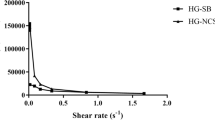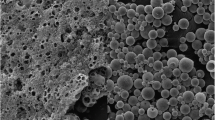Abstract
The purpose of this study was to develop micro and nano sized drug carriers from poly(3-hydroxybutyrate-co-3-hydroxyvalerate) (PHBV), and study the cell and skin penetration of these particles. PHBV micro/nanospheres were prepared by o/w emulsion method and were stained with a fluorescent dye, Nile Red. The particles were fractionated by centrifugation to produce different sized populations. Topography was studied by SEM and average particle size and its distribution were determined with particle sizer. Cell viability assay (MTT) was carried out using L929 fibroblastic cell line, and particle penetration into the cells were studied. Transdermal permeation of PHBV micro/nanospheres and tissue reaction were studied using a BALB/c mouse model. Skin response was evaluated histologically and amount of PHBV in skin was determined by gas chromatography-mass spectrometry. The average diameters of the PHBV micro/nanosphere batches were found to be 1.9 μm, 426 and 166 nm. Polydispersity indices showed that the size distribution of micro sized particles was broader than the smaller ones. In vitro studies showed that the cells had a normal growth trend. MTT showed no signs of particle toxicity. The 426 and 166 nm sized PHBV spheres were seen to penetrate the cell membrane. The histological sections revealed no adverse effects. In view of this data nano and micro sized PHBV particles appeared to have potential to serve as topical and transdermal drug delivery carriers for use on aged or damaged skin or in cases of skin diseases such as psoriasis, and may even be used in gene transfer to cells.









Similar content being viewed by others
References
Sloan KB, Wasdo SC, Rautio J. Design for optimized topical delivery: prodrugs and a paradigm change. Pharm Res. 2006;26:2729–47.
Yow HN, Wu X, Routh AF, Guy RH. Dye diffusion from microcapsules with different shell thickness into mammalian skin. Eur J Pharm Biopharm. 2009;72:62–8.
Gawkrodger DJ. Dermatology, vol. 1. New York: Edinburgh Churchill Livingstone Inc; 2002.
Prausnitz MR, Langer R. Transdermal drug delivery. Nature Biotechnol. 2008;26:1261–8.
Arora A, Prausnitz MR, Mitragotri S. Micro-scale devices for transdermal drug delivery. Int J Pharm. 2008;364:227–36.
Wosicka H, Cal K. Targeting to the hair follicles: current status and potential. J Dermatol Sci. 2010;57:83–9.
Prow TW, Grice JE, Lin LL, Faye R, Butler M, Wurme EMT, et al. Nanoparticles and microparticles for skin drug delivery. Adv Drug Deliv Rev. 2011;63:470–91.
Gursel I, Korkusuz F, Türesin F, Alaeddinoğlu NG, Hasırcı V. In vivo application of biodegradable controlled antibiotic release systems for the treatment of implant-related osteomyelitis. Biomaterials. 2001;22:73–80.
Jahanshahi M, Babaei Z. Protein nanoparticle: a unique system as drug delivery vehicles. Afr J Biotechnol. 2008;7:4926–34.
Rieux AD, Fievez V, Garinot M, Schneider YJ, Préat V. Nanoparticles as potential oral delivery systems of proteins and vaccines: a mechanistic approach. J Control Release. 2006;116:1–27.
Xia T, Kovochich M, Liong M, Meng H, Kabehie S, George S, et al. Polyethyleneimine coating enhances the cellular uptake of mesoporous silica nanoparticles and allows safe delivery of siRNA and DNA constructs. ACS Nano. 2009;3:3273–328.
Yilgor P, Hasirci N, Hasirci V. Sequential BMP-2/BMP-7 delivery from polyester nanocapsules. J Biomed Mater Res Part A. 2010;93:528–36.
Yin WK, Feng SS. Effects of particle size and surface coating on cellular uptake of polymeric nanoparticles for oral delivery of anticancer drugs. Biomaterials. 2005;26:2713–22.
Hasirci V, Vrana E, Zorlutuna P, Ndreu A, Yilgor P, Basmanav FB, et al. Nanobiomaterials: a review of the existing science and technology, and new approaches. J Biomater Sci Polym Edn. 2006;17:1241–68.
Hasirci V, Yucel D. Polymers used in tissue engineering. Encyclopedia Biomater Biomed Eng. 2007;1:1–17.
Boyandin AN, Prudnikova SV, Filipenko ML, Khrapov EA, Vasil’ev AD, Volova TG. Biodegradation of polyhydroxyalkanoates by soil microbial communities of different structures and detection of PHA degrading microorganisms. Appl Biochem Microbiol. 2012;48:28–36.
Sudesh K, Abe H, Doi Y. Synthesis, structure and properties of polyhydroxyalkanoates: biological polyesters. Prog Polym Sci. 2000;25:1503–55.
Shishatskaya E, Goreva A, Kalacheva G, Volova TG. Biocompatibility and resorption of intravenously administered polymer microparticles in tissues of internal organs of laboratory animals. J Biomater Sci Polym Edn. 2011;22:2185–203.
Hasirci V, Yilgor P, Endogan T, Eke G, Hasirci N. Polymer fundamentals: Polymer synthesis. In: Ducheyne P, Healy K, Hutmacher D, Grainger DW, Kirkpatrick CJ editors. Comprehensive Biomaterials 2011;1:349–371.
Goreva AV, Shishatskaya EI, Volova TG, Sinskey AJ. Characterization of polymeric microparticles based on resorbable polyesters of oxyalkanoic acids as a platform for deposition and delivery of drugs. Polym Sci Series A Med Polym. 2012;54:94–105.
Davidson PM, Ozcelik H, Hasirci V, Reiter G, Anselme K. Microstructured surfaces cause severe but non-detrimental deformation of the cell nucleus. Adv Mater. 2009;21:3586–90.
Goope NV, Roberts DW, Webb P, Cozart CR, Siitonen PH, Latendrese JR, et al. Quantitative determination of skin penetration of PEG-coated Cd Se quantum dots in dermabraded but not intact SKH-1 hairless mouse skin. Toxicol Sci. 2009;1:37–48.
Chen WH, Tang BL, Tong YW. PHBV Microspheres as tissue engineering scaffold for neurons. IFMBE Proc. 2009;23:1208–12.
Xiong YC, Yao YC, Zhan XY, Chen GQ. Application of polyhydroxyalkanoates nanoparticles as intracellular sustained drug-release vectors. J Biomater Sci. 2010;21:127–40.
Crowley TJ, Meadows ES, Kostoulas E, Doyle FJ. Control of particle size distribution described by a population balance model of semi batch emulsion polymerization. J Process Control. 2000;10:419–32.
Errico C, Bartoli C, Chiellini F, Chiellini E. Poly(hydroxyalkanoates) based polymeric nano particles for drug delivery. J Biomed Biotechnol. 2009;10:1–10.
Abulateefeh SR, Sebastian G, Spain SG, Thurecht KJ, Aylott JW, Chan WC, Garnetta MC, Cameron Alexander C. Enhanced uptake of nanoparticle drug carriers via a thermoresponsive shell enhances cytotoxicity in a cancer cell line. Biomater Sci. 2013;1:434–42.
Simone Lerch S, Dass M, Musyanovych A, Landfester K, Mailander V. Polymeric nanoparticles of different sizes overcome the cell membrane barrier. Eur J Pharm Biopharm. 2013;84:265–74.
Sohaebuddin SK, Thevenot PT, Baker D, Eaton JW, Tang L. Nanomaterial cytotoxicity is composition, size, and cell type dependent. Particle Fibre Toxicol. 2010;7:22–30.
Wang W, Zhou S, Guo L, Zhi W, Li X, Weng J. Investigation of endocytosis and cytotoxicity of poly-d, l-lactide-poly(ethylene glycol) micro/nano-particles in osteoblast cells. Int J Nanomed. 2010;5:557–66.
Desai MP, Labhasetwar V, Walter E, Levy RJ, Amidon GL. The mechanism of uptake of biodegradable microparticles in Caco-2 cells is size dependent. Pharm Res. 1997;14:1568–73.
Sahoo SK, Panyam J, Prabha S, Labhasetwar L. Residual polyvinyl alcohol associated with poly (d, l-lactide-co-glycolide) nanoparticles affects their physical properties and cellular uptake. J Controlled Release. 2002;82:105–14.
Foster KA, Yazdanian M, Audus KL. Microparticulate uptake mechanisms of in vitro cell culture models of the respiratory epithelium. J Pharm Pharmacol. 2001;53:57–66.
Benfer M, Kissel T. Cellular uptake mechanism and knockdown activity of siRNA-loaded biodegradable DEAPA-PVA-g-PLGA nanoparticles. Eur J Pharm Biopharm. 2012;80:247–56.
Wermeling DP, Banks SP, Hudson DA, Gill HS, Gupta J, Prausnitz MR. Micro needles permit transdermal delivery of a skin-impermeant medication to humans. Proc Natl Acad Sci. 2008;105:2058–63.
Baroli B. Penetration of nanoparticles and nanomaterials in the skin: fiction or reality. J Pharm Sci. 2010;99:21–50.
Tomoda K, Terashima H, Suzuki K, Inagi T, Terada H, Makino K. Enhanced transdermal delivery of indomethacin-loaded PLGA nanoparticles by iontophoresis. Colloids Surf B. 2011;88:706–10.
Webster TJ. Editor. Nanostructure science and technology: Safety of nanoparticles from manufacturing to medical applications. Springer Science and Business Media, LLC. 2009 Available from URL: http://www.springer.com/series/6331. Accessed 15 Feb 2013.
Acknowledgments
The study was supported by the Government of the Russian Federation (Decree No. 220 of 09.04.2010) (Agreement No. 11.G34.31.0013) and (Grant № MD-3112.2012.4). We gratefully acknowledge the EC FP7 SKINTREAT project and the State Planning Organization (Turkey) for the grant to establish BIOMATEN. Mr. A. Büyüksungur is acknowledged for his contributions with CLSM.
Author information
Authors and Affiliations
Corresponding author
Rights and permissions
About this article
Cite this article
Eke, G., Kuzmina, A.M., Goreva, A.V. et al. In vitro and transdermal penetration of PHBV micro/nanoparticles. J Mater Sci: Mater Med 25, 1471–1481 (2014). https://doi.org/10.1007/s10856-014-5169-5
Received:
Accepted:
Published:
Issue Date:
DOI: https://doi.org/10.1007/s10856-014-5169-5




